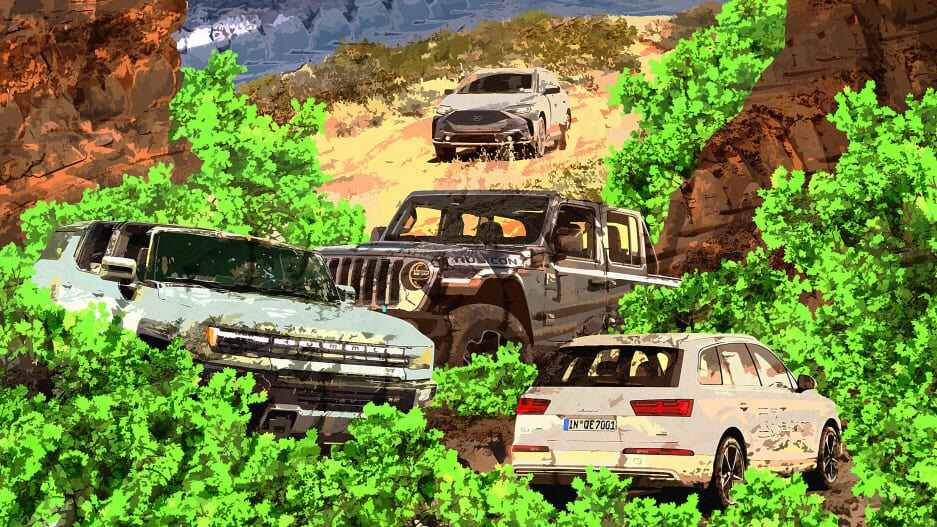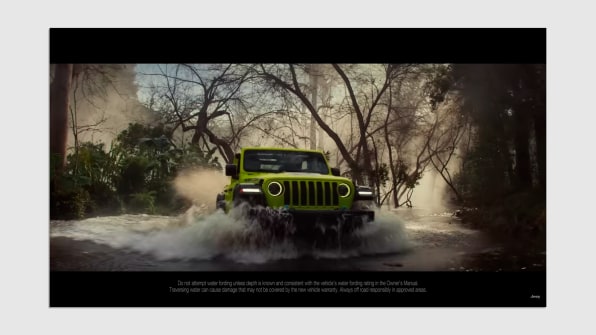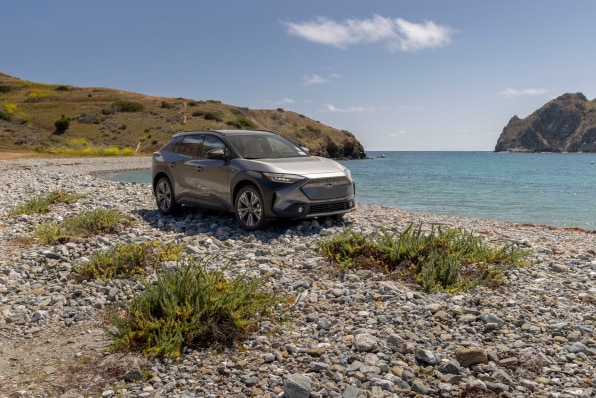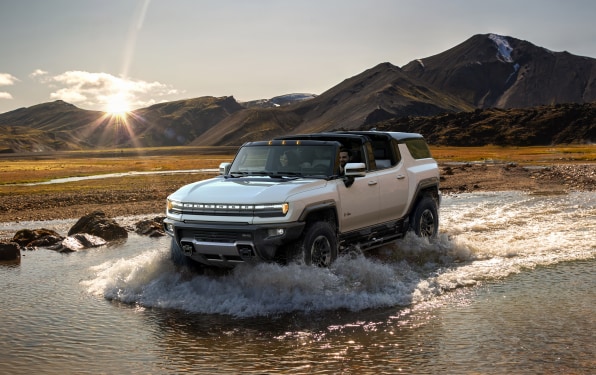- | 10:00 am
The blatant greenwashing of SUVs
The Jeep ad during the Super Bowl was just the latest example of car companies trying to draw positive connections between their SUVs and the great outdoors.

If you were one of the 113 million people who watched the Super Bowl this month, you might have seen a TV ad resembling an interspecies dance party.
From Fiat Chrysler, the one-minute clip featured the Jeep 4xe, a plug-in hybrid SUV, zooming across grasslands, forests, and deserts; at one point the vehicle plunges into a stream, kicking up plumes of water. With Electric Boogie blasting from its stereo, the Jeep is welcomed by a veritable Noah’s Ark of celebrating creatures, including bopping bees, swinging seals, and grooving giraffes. A viewer might wonder if Mother Earth herself gives each buyer a high five after the dealer hands over the keys.

This, my friends, is greenwashing.
Like many SUV ads, Jeep’s commercial implies an allyship between big cars and the environment that does not exist. In reality, you should never, ever drive your car across a streambed; as nonprofits like Trout Unlimited have long warned; doing so destroys fragile ecosystems. While the CGI-created animals in Fiat Chrysler’s ad grin ear to ear (or antenna to antenna) as they frolic alongside the hybrid Jeep, in the real world, the height of SUVs makes them deadlier to animals (as well as humans). And the enormity of electric SUVs worsens the destruction from mining minerals like cobalt and lithium—and could even catalyze climate change.
For decades, carmakers have used savvy marketing to conceal the environmental damage inflicted by SUVs. Simply electrifying these Goliath-like cars will not make them good for the planet—however much carmakers want you to believe otherwise.
The greenwashing of SUVs began decades ago, long before they became ubiquitous on American streets. The vehicles started to go mainstream in the 1980s, propelled by a combination of low gas prices, a federal fuel economy loophole, and—crucially—a carefully honed image of power and outdoorsiness. Typical ads of the 1990s featured SUVs smashing through pristine sand dunes and traversing steep mountain roads en route to lakeside campsites.
In a 2004 study of SUV advertising, Simon Fraser University communications professor Shane Gunster noted, “More often than not, the landscape remains untouched as the SUV slips through, blending into the natural environment. . . . The SUV is offered as a technology for the redemption of nature, a lens through which we might glimpse its secret aesthetics and truly experience and appreciate its sublime majesty.” He estimated that $9 billion were spent marketing SUVs between 1990 and 2001, including camping gear sent to car dealerships.
The investment paid off. In his 2004 book, High and Mighty: The Dangerous Rise of the SUV, journalist Keith Bradsher wrote, “Affluent baby-boomer families who loved nature were the core of the environmental movement, and they were also the main market for SUVs.” Although SUVs’ woeful gas mileage has always made them terrible for the planet, Bradsher suggested that environmental advocates were slow to respond to their ascent in order to avoid alienating their members.
Eventually, prominent environmental groups did raise alarms about the SUV-ification of American cars. Twenty-five years ago, the Sierra Club held a public contest to name Ford’s new and enormous SUV, later dubbed the Excursion, which weighed around 7,000 pounds and got roughly 10 mpg in the city. The Sierra Club’s chosen name: The Ford Valdez, a reference to the Exxon oil tanker that ran aground in 1989, wreaking havoc in Alaska’s Prince William Sound. In 2005, Ford ceased production of the Excursion; two years later, Time named it one of the worst cars of all time.
The Sierra Club may have won that battle, but it lost the war against SUVs. Large models have steadily added inches and pounds, while new crossovers have helped SUVs grab additional market share from sedans (and, more recently, from pickups, too). Today, over half the new cars sold in the U.S. are SUVs, a trend welcomed by carmakers collecting juicy profits from their sales.

Automakers have made minimal progress taming SUVs’ gas-guzzling tendencies. (Models like the Cadillac Escalade and Ford Bronco still get below 20 mpg.) But now carmakers are electrifying their SUVs and amplifying their environmental messaging. A recent ad for the Audi Q7 e-tron titled “Sounds of Nature” shows the vehicle quietly traversing forests and shores, with a claim that the car “changes the world.” Another one for the Subaru Solterra features geese soaring, a geyser erupting, and a raindrop slowly tumbling off a leaf.
But such environmental positioning remains deeply misleading. While electric SUVs do not produce tailpipe emissions, they will damage the planet in many other ways. Because they are so heavy, SUVs require gigantic batteries in order to provide the 300-plus miles of range that carmakers insist are necessary (an assumption that’s dubious, by the way). Charging those batteries requires generating a lot of power, which itself creates considerable emissions. Particularly oversized SUVs, like the Hummer EV, can produce more greenhouse gases per mile than a gas-powered sedan. Recent research found that they could even hasten climate change by slowing the process of electrifying smaller, more efficient vehicles.

Catalyzing climate change is not the only way in which electric SUVs harm the environment. Critical minerals within batteries must be extracted from the earth, which is a messy process. “Production of raw materials like lithium, cobalt, and nickel that are essential to these technologies are often ruinous to land, water, wildlife, and people,” wrote the New York Times in 2021. A recent study found that limiting the size of electric vehicles (i.e., producing sedans instead of SUVs) could itself reduce U.S. lithium demand by 42%, even if Americans drove as much as they do today.
Regardless of how they are powered, SUVs do no favors for the animal kingdom. Some 350 million vertebrates are fatally struck by vehicles annually in the U.S., and roadkill deaths have risen sharply in recent decades. Ben Goldfarb, author of the forthcoming book, Crossings: How Road Ecology is Shaping the Future of Our Planet, said he does not believe that SUVs’ weight leads them to kill more animals (whether a car weighs 3,000 pounds or 7,000 pounds, its impact is likely to be deadly), but he has deep concerns about their height, which limits visibility in front of and behind the vehicle. “If you don’t see the animal, you can’t stop for it,” Goldfarb says. “You might see a deer behind you, but in a SUV, there’s no way you’ll see a fox or coyote. It’s likely that taller vehicles will lead to less braking for wildlife—and more roadkill.”
And don’t get Goldfarb started about the act of driving an SUV across a streambed, something that happens frequently in TV ads like the one for the Jeep 4xe. (Land Rover even offers guidance about how to do it.) “Streams and riparian areas are incredibly sensitive habitats,” he says. “When you plow through a streambed, you’re obliterating any fish eggs or amphibian larvae that happen to be there.”
The myriad environmental problems presented by electric SUVs are a reminder that a car should not be considered “green” simply because it is powered by a battery instead of crude oil. That truth is an inconvenient one for automakers, who are relying on nature-friendly marketing to sell their new, newly electrified behemoths—much as they did for gas-powered SUVs several decades ago.
If you want to align your transportation decisions with your environmental values, by all means, consider buying an electric car instead of a gas one—but see if you might make do with a sedan instead of an SUV (and whatever you buy, please, please don’t drive it over a streambed).
Better yet: Ditch the car entirely and try an e-bike, e-cargo bike, or golf cart, with a battery and carbon footprint that are tiny by comparison. You might not encounter any dancing animals, but you’ll be doing your part to protect them.






































